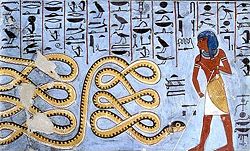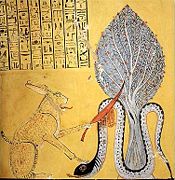Apep

In Egyptian mythology, Apep (also spelled Apepi, and Aapep, or Apophis in Greek) was an evil demon, the deification of darkness and chaos (isfet in Egyptian), and thus opponent of light and Ma'at (order/truth), whose existence was believed from the Middle Kingdom onwards. His name is reconstructed by Egyptologists as *ʕAʔpāpī because of written ʕ3pp(y), surviving into later Coptic as Aphōph.
Development
Apep formed part of the more complex cosmic system resulting from the identification of Ra as Atum, i.e. the creation of Atum-Ra, and the subsequent merging of the Ogdoad and Ennead systems. Consequently, since Atum-Ra, who was later referred to simply as Ra, was the solar deity, bringer of light, and thus the upholder of Ma'at, Apep was viewed as the greatest enemy of Ra, and thus was given the title Enemy of Ra.
As the personification of all that was evil, Apep was seen as a giant snake, crocodile, serpent, or in later years, in a few cases, as a dragon, leading to titles such as Serpent from the Nile, and Evil lizard. Some elaborations even said that he stretched 16 yards in length and had a head made of flint. It is to be noted that already on a Naqada I (ca. 4000 B.C.E.) C-ware dish (now in Cairo) a snake was painted combined with other desert and aquatic animals as a possible enemy of a solar god who is invisibly hunting in a big rowing vessel (C.Wolterman, in: Jaarbericht van Ex Oriente Lux, Leiden (Holland) Nr. 37 (2002)). Also, comparable hostile snakes as enemies of the sun god existed under other names (in the Pyramid Texts and Coffin Texts) already before the name Apep occurred. The etymology of his name ('pp) is perhaps to be sought in some west-semitic language where a word root "pp meaning 'to slither' existed. A verb root 'pp does at any rate not exist elsewhere in Ancient Egyptian. Apep's name much later came to be falsely connected etymologically in Egyptian with a different root meaning (he who was) spat out; the Romans referred to Apep by this translation of his name.
Apparently because of the spat out interpretation of the name Apep, it was said that he had been formed by Neith, who had been the deification of the primordial waters in the Ennead, from a length of spit she had spat at Nu, the deification of the primordial waters in the Ogdoad. Some subsequent commentators speculated that Apep must have been an earlier creator, and chief god, thus explaining why he had so much enmity towards Ra, but evidence for such a conclusion is slight.
After the end of the Middle Kingdom, the foreign Hyksos, now rulers over Egypt, chose Set, as their favorite deity, since he had been protector of Ra, and was associated with Lower Egypt, where their power base was. Consequently, because the foreign overlords were hated by nationalistic groups, Set became gradually demonised, and started being thought of as an evil god. Indeed, because of the extreme level of nationalism and xenophobia, Set eventually became thought of as the god of evil, and gradually took on all the characteristics of Apep. Consequently, Apep's identity was eventually entirely subsumed by that of Set.[citation needed]
Battles with Ra

Tales of Apep's battles against Ra were elaborated during the New Kingdom. Since nearly everyone can see that the sun is not attacked by a giant snake during the day, every day, story tellers said that Apep must lie just below the horizon. This appropriately made him a part of the underworld, which attacked the sun each night. In some stories Apep waited for Ra in a western mountain called Bakhu, where the sun set, and in others Apep lurked just before dawn, in the Tenth region of the Night. The wide range of Apep's possible location gaining it the title World Encircler. It was thought that his terrifying roar would cause the underworld to rumble. Myths sometimes say that Apep was trapped there, because he had been the previous chief god and suffered a coup d'etat by Ra, or because he was evil and had been imprisoned.
In his battles, Apep was thought to use a magical gaze to hypnotise Ra and his entourage, attempting to devour them whilst choking the river on which they travelled through the underworld with his coils. Sometimes Apep had assistance from other demons, named Sek and Mot. Ra was assisted by a number of defenders who travelled with him, the most powerful being Set, who sat at the helm. Other gods who feature in later tales as the defenders include fierce warriors such as Mehen, Serket, Maahes, and Bast, together with Shu.
In a bid to explain natural phenomena it was said that occasionally Apep got the upper hand. The damage to order caused thunderstorms and earthquakes. Indeed: it was even thought that sometimes Apep actually managed to swallow Ra during the day, causing a solar eclipse, but since Ra's defenders quickly cut him free of Apep, the eclipse always ended within a few minutes. On the occasions when Apep was said to have been killed, he was able to return each night (since he lived in the world of the dead already). In Atenism it is Aten who kills the monster, obviously, since Aten is the only god in the belief system.
Worship
Apep was not so much worshipped, as worshipped against. His defeat each night, in favour of Ra, was thought to be ensured by the prayers of the Egyptian priests and worshipers at temples. The Egyptians practiced a number of rituals and superstitions that were thought to ward off Apep, and aid Ra to continue his journey across the sky.
In an annual rite, called the Banishing of Apep, priests would build an effigy of Apep that was thought to contain all of the evil and darkness in Egypt, and burn it to protect everyone from Apep's influence for another year, in a similar manner to modern rituals such as Zozobra.
The Egyptian priests even had a detailed guide to fighting Apep, referred to as The Books of Overthrowing Apep or (in Greek) the Book of Apophis. The chapters described a gradual process of dismemberment and disposal, and include:
- Spitting Upon Apep
- Defiling Apep with the Left Foot
- Taking a Lance to Smite Apep
- Fettering Apep
- Taking a Knife to Smite Apep
- Putting Fire Upon Apep
In addition to stories about Apep's defeats, this guide had instructions for making wax models, or small drawings, of the serpent, which would be spat on, mutilated and burnt, whilst reciting spells that would aid Ra. Fearing that even the image of Apep could give power to the demon, any rendering would always include another deity to subdue the monster.
As Apep was thought to live in the underworld, he was sometimes thought of as an Eater-up of Souls. Thus the dead also needed protection, so they were sometimes buried with spells that could destroy Apep. The Book of the Dead frequently described occasions when Ra defeated Apep.
Influences
- The asteroid 99942 Apophis, an Aten-class asteroid, is named in its honour, because it was at Level 4 on the Torino impact hazard scale between 2004 and 2006 - see this article.
- The name Apophis was given to the first major false god enemy in the sci-fi series Stargate SG-1
- The myth of Apep battling Ra features within the main plot of Per-Bast: A Tale of Cats in Ancient Egypt
- The name Apep Heidemann was given to the major antagonist in the Japanese manga Seraphic Feather.
- The Books of Overthrowing Apep inspired the song Papyrus Containing The Spell To Protect The Possessor From Attacks From He Who Is In The Water on the 2007 album Ithyphallic by the death metal band Nile (who are known for their overall Egyptian theme). References to Apep appear in several other Nile songs.
External links
| Topics about Ancient Egypt edit | |||
|---|---|---|---|
| Places: Nile river | Niwt/Waset/Thebes | Alexandria | Annu/Iunu/Heliopolis | Luxor | Abdju/Abydos | Giza | Ineb Hedj/Memphis | Djanet/Tanis | Rosetta | Akhetaten/Amarna | Atef-Pehu/Fayyum | Abu/Yebu/Elephantine | Saqqara | Dahshur | |||
| Gods associated with the Ogdoad: Amun | Amunet | Huh/Hauhet | Kuk/Kauket | Nu/Naunet | Ra | Hor/Horus | Hathor | Anupu/Anubis | Mut | |||
| Gods of the Ennead: Atum | Shu | Tefnut | Geb | Nuit | Ausare/Osiris | Aset/Isis | Set | Nebet Het/Nephthys | |||
| War gods: Bast | Anhur | Maahes | Sekhmet | Pakhet | |||
| Deified concepts: Chons | Maàt | Hu | Saa | Shai | Renenutet| Min | Hapy | |||
| Other gods: Djehuty/Thoth | Ptah | Sobek | Chnum | Taweret | Bes | Seker | |||
| Death: Mummy | Four sons of Horus | Canopic jars | Ankh | Book of the Dead | KV | Mortuary temple | Ushabti | |||
| Buildings: Pyramids | Karnak Temple | Sphinx | Great Lighthouse | Great Library | Deir el-Bahri | Colossi of Memnon | Ramesseum | Abu Simbel | |||
| Writing: Egyptian hieroglyphs | Egyptian numerals | Transliteration of ancient Egyptian | Demotic | Hieratic | |||
| Chronology: Ancient Egypt | Greek and Roman Egypt | Early Arab Egypt | Ottoman Egypt | Muhammad Ali and his successors | Modern Egypt | |||
Credits
New World Encyclopedia writers and editors rewrote and completed the Wikipedia article in accordance with New World Encyclopedia standards. This article abides by terms of the Creative Commons CC-by-sa 3.0 License (CC-by-sa), which may be used and disseminated with proper attribution. Credit is due under the terms of this license that can reference both the New World Encyclopedia contributors and the selfless volunteer contributors of the Wikimedia Foundation. To cite this article click here for a list of acceptable citing formats.The history of earlier contributions by wikipedians is accessible to researchers here:
The history of this article since it was imported to New World Encyclopedia:
Note: Some restrictions may apply to use of individual images which are separately licensed.